History of the Pearls
For thousands of years, the fascination with pearls and their unique lustrous appearance has captivated every human society’s wild imagination about nature and power. In ancient India, people believed that pearls were made from dewdrops from heaven, and cherished them as a connection between gods and themselves. Persian myths also thought the pearl as a symbol of light and hope that was transformed from tears of gods.
Since the discovery of this magnificent creation by nature, thousands of people had risked their lives in the quest for these gems through the Persian Gulf to the waters of Central and South America. From the earliest times, pearls were exclusive to the rich and the powerful. Legend has it that, in order to show her wealth and power, Cleopatra drank the largest pearl in the world dissolved in vinegar on a bet with Marc Antony. The popularity of natural pearls increased over time among European monarchs following Columbus’ discovery of the New World. Queen Elizabeth I was renowned for her love of pearls by adorning herself with as many of them as possible.
The famous Armada portrait of Elizabeth I painted by George Gower in 1590 depicts her covered in these amazing gems and shows the world her position of power. The Renaissance saw many European royal courts ban the wearing of pearls by others outside the nobility. Pearls, with their shimmering iridescence and soft glow, became the ultimate emblem of wealth and social standing.

During the 19th century natural pearls were harvested relentlessly by collectors and traders. As a result, their supply began to diminish drastically. The continuous craving for these highly prized gems eventually led to the discovery of the pearl cultivating techniques.
Although the Chinese were able to produce the first blister pearls in the late 13th century, it was Kokichi Mikimoto from Japan who had won the credit of creating a thriving pearl cultivation industry. As a gifted salesperson with great passion and perseverance, Mikimoto saw the potential market for cultivating pearls. After many failed attempts, he managed to harvest Japan’s first cultured Akoya blister pearls in 1893. He continued to refine his cultivation techniques and began focusing on finding a method to produce cultured pearls consistently. By 1916, he started mass production of whole round pearls and expanded his business worldwide. Until today, many of his methods are still used in pearl culturing.
While natural pearls continue to be sought after by collectors for their rarity, over 90% of the gems sold in the market today are cultured. There are far more different colours and varieties than ever seen. More importantly, the advent of farming techniques has made these beautiful gems accessible to more consumers.
For many people, the pearl stands for health and purity. Unlike other gemstones, the pearl is the only gem made from a living creature. In many countries it is the birthstone for June. The pearl jewellery is also a traditional gift for the 30th wedding anniversary. Today, they are undoubtedly an important part of every woman’s jewellery wardrobe. A set of pearls can instantly add elegance and sophistication that projects a woman’s confidence in any occasions. From the business attire to the evening gown, women look more impressive and radiant when complemented with pearls.
What’s more important is that these jewels are no longer considered only for formal wear. In addition to their classic and chic image, pearls have gained increasing popularity as accessories for the casual yet stylish attire. They bring out the fun element of the jewellery and do wonders for the wearer’s personality. Celebrities such as Jessica Biel and Katherine Heigl are always spotted with these beautiful gems on them. Pearls have indeed become a symbol of fashion that women of all ages and lifestyles can wear with every look.
*image: Portrait of Elizabeth I




